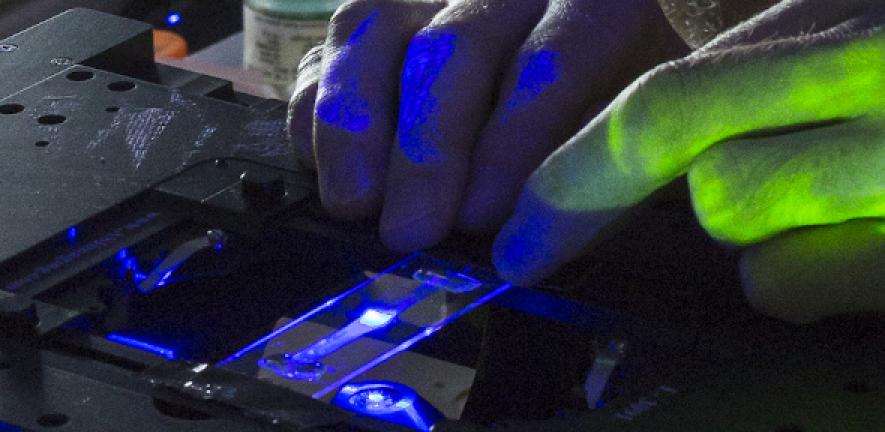
In a new ‘bio-mimetic’ approach published in the Journal of the American Chemical Society, researchers used tiny microfluidic devices developed in the Sir Rodney Sweetnam Microfluidics Laboratory to replicate the shear forces exerted by capillary walls in the bloodstream. “In chemistry, biomimetic approaches have often focused on copying nature’s chemical toolkit, but we decided to complement this by emulating nature’s physical architectures, which as a tool to control chemical reactions have remained largely unexplored,” says Professor Tuomas Knowles of this Department.
The forces on cells and biomolecules within living systems such as the human body are known to affect their behaviour. For example, proteins crowded too tightly inside cells are more likely to form into the amyloid fibrils associated with Alzheimer’s disease and Type II diabetes. Researchers had observed these and other biochemical changes within cells, but how these changes were linked to the mechanical forces acting on the proteins was less understood.
In the new bio-mimetic approach, members of the Knowles and Bernardes groups used tiny microfluidic reactors to replicate the smallest dimensions and shear stresses found in human capillaries. Shear stress occurs when forces acting on a single body, such as a cell or a protein, pull it in different directions at the same time.
The team then conducted microfluidics experiments at various shear stresses while observing amino acids susceptible to post-translational modifications, which are modifications to amino-acid side chains that occur naturally after a cell produces a protein. The team observed how the chemical reaction rates changed in the selected amino acids by tagging them with fluorescence-generating reporter molecules. They found that biologically plausible shear stresses could double some chemical reaction rates.
These increased reaction rates could lead to increased rates of post-translational modifications, impacting signaling pathways and a cell’s associated biochemical responses to mechanical forces. “I think it’s previously been assumed that these modest levels of shear would have little effect on chemical modifications of the protein,’ says Knowles, ‘but our work shows that this is not necessarily the case.”
The results matched molecular dynamics simulations led by Professor Francisco Corzana at the University of La Rioja, Spain. “The molecules undergo a local deformation,” explains Corzana. “So the protein, say, probably keeps its biological activity, but some amino acids which were masked are now exposed to the solvent and can react easily.”


Joint first authors postdoctoral researcher Emma Yates (left) and PhD student Tuuli Hakala.
The researchers then used the joint microfluidic, mass spectrometry and simulation approach to study the activity of Trastuzumab, a monoclonal antibody recently developed to treat an aggressive type of breast cancer. “We found that some of the Trastuzumab antibodies may be partially dissociated under shear stress conditions,” says Dr Gonçalo Bernardes of this Department and the Institute of Molecular Medicine, Portugal. “This is bad because if the light and heavy chain of an antibody dissociate, it may lose antigen-binding properties and thus function. There are many such antibodies now in the clinic, and it’s important to understand how they behave, for example, while in the circulatory system. This new technique will help us to understand and influence how existing therapeutic antibodies act in blood plasma.”
Using this approach, it could theoretically be possible to select therapeutic antibodies less likely to dissociate in the circulation.
The results also suggest that bio-physically mimetic chemistry is a link between biophysics and biochemistry in which the variety of forces utilized by nature to alter biomolecular behaviour can be exploited for human purposes.
Research
TA Hakala, EV Yates, PK Challa, Z Toprakcioglu, K Nadendla, D Matak-Vinkovic, CM Dobson, R Martinez, F Corzana, TPJ Knowles and GJL Bernardes, Accelerating reaction rates of biomolecules by using shear stress in artificial capillary systems, J. Am. Chem. Soc. (4 Oct 2021).

